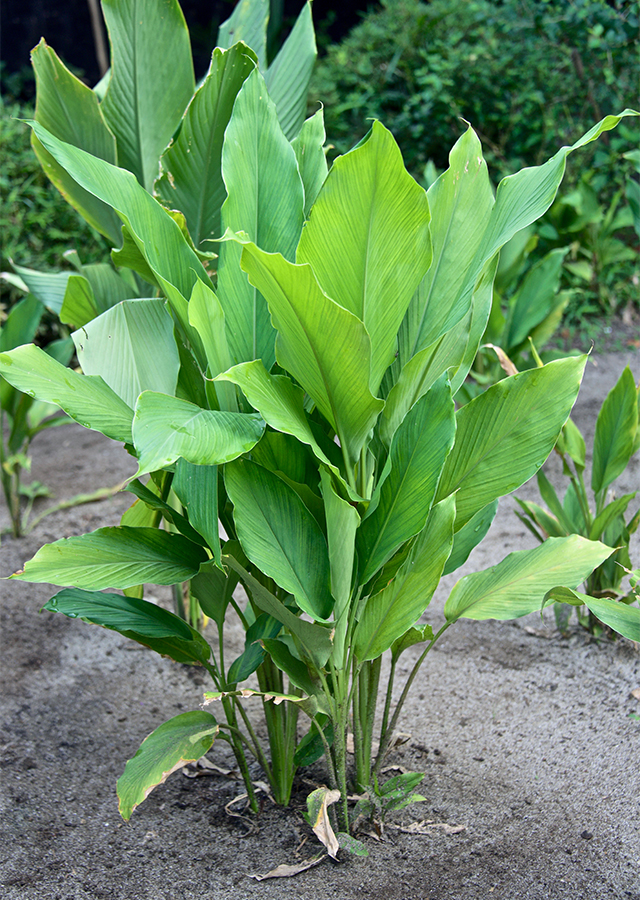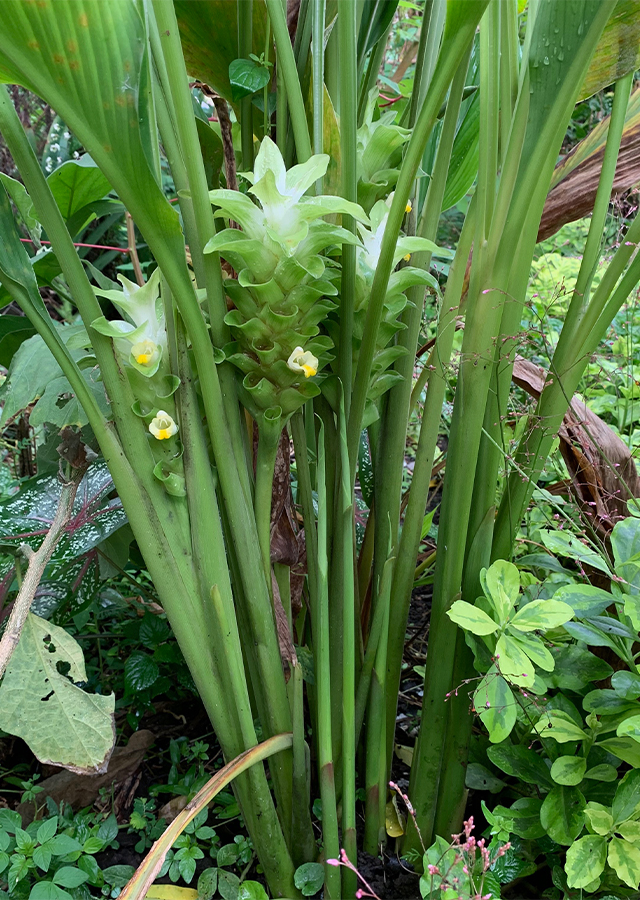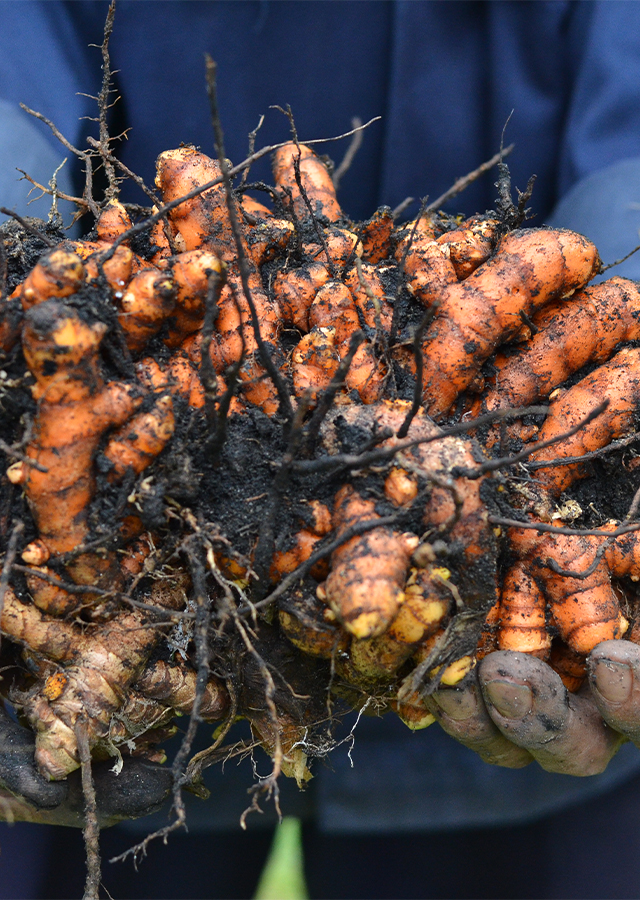Turmeric
Curcuma longa L.
Zingiberaceae
Location in our garden
Principal



Synonym
Amomum curcuma Jacq.
Curcuma brog Valeton
Curcuma domestica Valeton
Habitus
Herbaceous. A perennial plant growing about 1 m tall from an underground rhizome
Part Used
Leaves
Flowers
Rhizome
Growing Requirements
Full Sunshine
Need Shade
Habitat
Forest
Terrestrial
Overview
Turmeric originates from India and southern Asia and is now grown in the tropics. In Asian cuisine, turmeric rhizome is used as a culinary spice, being an integral component of curry powder, used in processed foods as a coloring agent and flavoring agent. Turmeric is increasingly recognized with almost unprecedented health benefits as a medicinal ingredient.
Vernacular Names
Aurukesafur (Arabic), Khminz khünz (Laos), Curcurma (French), Halodhi (India), Ukon (Japanese), Dilaw (Philippines), Khamin (Thailand), Nanwin (Myanmar).
Agroecology
With a high annual rainfall of 1,500-2,000 mm and temperatures of 18-30 °C, turmeric thrives in a warm and wet tropical environment. It is hygrophilous and grows in full sun or partial shade at low altitudes below 1,500 m on well-drained soil and humid climate.
Morphology
- Roots - rhizome, much branched, aromatic tubers with color orange-yellow.
- Stems - it reaches 3 ft (90 cm) with a short, green or purple-tinted stem. Sparse to densely pubescent are the petiole and sheath.
- Leaves - lance-shaped, radical, entire and long sheathed, green, elliptic, 30-50 cm long by 10-25 cm wide and glabrous, the base is attetunate and the apex is shortly acuminate.
- Flowers - hermaphrodite, zygomorphic, threefold, fused, have fluffy hairs white and puberulent, calyx obovate labellum 1.22 cm long, yellowish-white, corolla white to yellowish-white. The anther is spurred at the base.
- Fruits - capsule, opens with three compartments.
- Seeds - celled, ellipsoid seeds and with arillate seeds.
Cultivation
- Generative propagation by seeds, sown as soon as it is ripe. The best germination is at temperatures about 20 °C.
- Division of the rhizome by cuttings from the root while the plant is dormant. Within about 7 to 9 months after planting, the rhizomes are ready for harvesting.
- Fresh raw turmeric yields between 7 and 9 tons per hectare when turmeric is cultivated as a rain-fed crop.
Chemical Constituents
- Rhizomes: curcumenol, riboflavin, thiamine, minerals, amino acids, isoprocurcumenol, zedoaronediol, procurcumenol, phenolic, curcumin, resin.
- Leaves: extract turmeric leaves phytochemicals, monoterpenes, phellandrene, terpinolene, cineole, pinene.
- Flowers: essential oil yield from flowers 0.3 % with the major components curcumene, terpinolene, cymene, terpineol, nerolidol, turmerone, zingiberene, curlone.
Traditional Medicinal Uses
- Rhizomes are pungent, bitter, ancient herbs for digestive problems such as acidity and gastritis, which helps increase the production of mucus and protects the stomach, inflammatory conditions such as asthma and eczema, properties that lower blood and cholesterol, fungal infections (foot athletes), skin complaints, poor circulation, uterine tumors, jaundice, liver disease, menstrual problems, rheumatism, tuberculosis and cough relief.
- Turmeric is strongly antibacterial.
- Leaves are used for bruises and painful skin. Leaf juice is used to treat sore eyes. The vapour from the crushed leaves is inhaled to treat colds and runny noses.
- In Philippines, the rhizome with coconut oil is used as stomachic and vulnerary.
- In China, it is used for colic, amenorrhea, stuffiness.
- In India, it is used as an antiseptic for cuts, leprosy, problems with the liver, swelling, bites of insects, wounds, whooping cough and pimples.
Part Used
Reference Sources
- Shahab-Uddin, M.A., Ahmed, A., Usmanghani, K., Hannan, A., Mohiuddin, E., Asif, M. (2014). Curcuma longa and curcumin: A review article. Rom. J. Biol. – Plant Biol. 55(2): 65-70
- Kurniawan, C., Siagian, J.W., Hutomo, S. (2016). Sitotoksisitas ekstrak etanolik Curcuma longa pada sel hela, studi in vitro. Berkala Ilmiah Kedokteran Duta Wacana 1(3): 165-172
- Shan, C.Y., Iskandar, Y. (2018). Studi kandungan kimia dan aktivitas farmakologi tanaman kunyit (Curcuma longa L.). Farmaka Suplemen 16(2): 547-555


